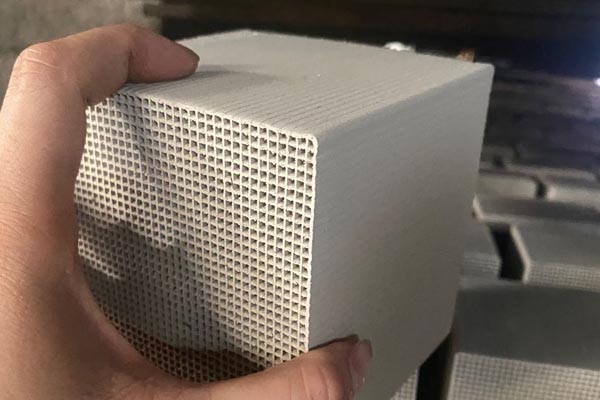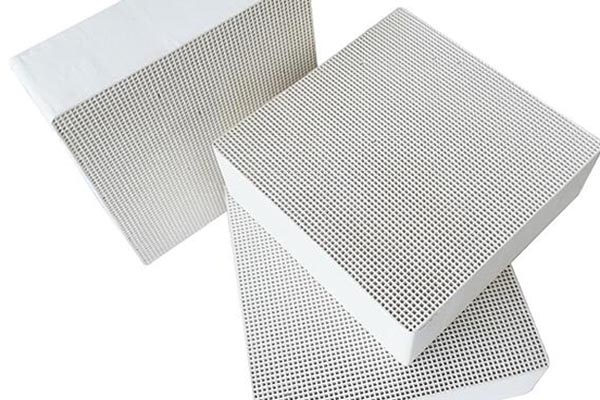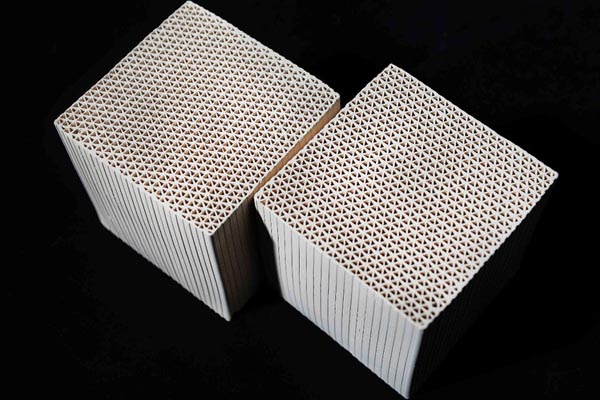
Zeolite honeycomb molecular sieve manufactor Microporous molecular sieves with molecular pore size below 2 nm and mesoporous molecular sieves with molecular pore size between 2-50 nm (50 nm The above are macroporous molecular sieves), mesoporous molecular sieves have high specific surface area, regular and orderly pore structure, narrow pore size distribution, continuous and adjustable pore size and other characteristics, which make it play an important role in the adsorption, separation and catalytic reaction of macromolecules that are difficult for many microporous molecular sieves to complete. Therefore, molecular sieve materials with different properties and pore sizes shall be configured according to the different components of organic waste gas during selection, so as to achieve targeted organic waste gas treatment, meet the design requirements and emission standards. The main material of honeycomb zeolite adsorbent is natural zeolite. The manufacturer of zeolite is composed of silica Inorganic microporous material composed of al_2o_3 and alkaline metal or alkaline earth metal, with inner pore volume accounting for 40-50% of the total volume and specific surface area of 100-500 m2/g, is characterized by high temperature resistance, non flammability, good thermal stability and hydrothermal stability. It is an efficient molecular sieve carrier with good adsorption performance, no secondary pollution, and can be regenerated at high temperature. Compared with honeycomb activated carbon, its performance is about 25% of its efficiency, However, it is widely used in the fields of adsorption, separation, catalysis and environment due to its high temperature resistance and difficult ignition, Zeolite honeycomb molecular sieve major It is more suitable for the treatment of organic waste gas with large air volume and low concentration.

Zeolite honeycomb molecular sieve major 1. From the composition of both, carbon molecular sieve is an excellent non-polar carbon material, while zeolite molecular sieve is a hydrate of crystalline aluminosilicate metal salt. The two are completely different in the periodic table of chemical elements! 2. With different pore sizes, the pore composition of zeolite molecular sieves is clearly registered, which can be generally divided into macropores, mesopores and micropores, and there are interconnections between the pores, while carbon molecular sieves are generally micropores! 3. The adsorption principle is different. Zeolite molecular sieves absorb molecules of certain size and repel molecules of larger substances. Zeolite honeycomb molecular sieve Zhejiang Carbon molecular sieve contains a large number of micropores, which can effectively separate the components of gas mixture. 4. The uses are also different. Carbon molecular sieves are widely used in coal fields, petroleum, chemicals, metal heat treatment, electronic manufacturing, food preservation and other industries, while zeolite molecular sieves can be used in addition to petroleum, chemicals, natural gas, electronic production, industrial gas separation, pharmaceutical industry, refrigeration industry, and hollow glass manufacturing.

Zeolite honeycomb molecular sieve major The addition of retention aids in the wet end of paper making is an important way to improve filler retention, which has been widely used in industrial production. Some studies reported that clinoptilolite (particle size 0.5-2 μ m) was used as a microparticle retention aid to compare the retention effect with silica and bentonite microparticle retention aid systems. The retention effect of clinoptilolite retention aid is equivalent to that of the silica microparticle retention aid system with the same dosage, which is far better than that of the bentonite microparticle retention aid system. And the use of zeolite as paper filler eliminates the need for additional microparticle retention aids. It is also reported that the retention rate of TiO2 nanoparticles can be significantly improved by using zeolite molecular sieves as retention aids in the preparation of photocatalytic paper. Compared with starch and cationic polymer, zeolite molecular sieve microparticle retention aids have better effects on improving the retention and drainage properties of paper stock and improving the uniformity of paper. Zeolite honeycomb molecular sieve major The use of zeolite particle retention aids can effectively avoid flocculation between fibers, and help to form fiber particle fiber flocculating particles. In addition, it can also support titanium dioxide nanoparticles.

Zeolite honeycomb molecular sieve Zhejiang Zeolite molecular sieve carrier has many advantages: 1. It is stable in operation, and the concentration of waste gas can reach the standard stably; 2. It can be desorbed at high temperature, with high regeneration efficiency and high safety; 3. Honeycomb zeolite is used as the adsorption carrier, with small resistance; 4. Compact structure, small floor area of the whole equipment. 5. It has a wide range of applications and is suitable for treating various organic waste gases. The main material of honeycomb zeolite adsorbent is natural zeolite. The manufacturer of zeolite is composed of silica Inorganic microporous material composed of al_2o_3 and alkaline metal or alkaline earth metal, with inner pore volume accounting for 40-50% of the total volume and specific surface area of 100-500 m2/g, is characterized by high temperature resistance, non flammability, good thermal stability and hydrothermal stability. It is an efficient molecular sieve carrier with good adsorption performance, no secondary pollution, and can be regenerated at high temperature. Compared with honeycomb activated carbon, its performance is about 25% of its efficiency, However, it is widely used in the fields of adsorption, separation, catalysis and environment due to its high temperature resistance and difficult ignition. It is more suitable for the treatment of organic waste gas with large air volume and low concentration. Zeolite honeycomb molecular sieve major

Molecular sieve has clear pore cavity distribution, extremely high internal surface area (600m2/s), good thermal stability (1000 ℃), and adjustable acid site center. The acidity of molecular sieve mainly comes from three coordinated aluminum atoms and aluminum ions (AlO)+on the framework and in the pores. OH based acid sensitive site center on molecular sieve HY obtained by ion exchange, Zeolite honeycomb molecular sieve Zhejiang The aluminum ions outside the framework will strengthen the acid site and form the L acid site center. Polyvalent cations such as Ca2+, Mg2+and La3+can show the acid site center after exchange. The reduction of transition metal ions such as Cu2+and Ag+can also form acid site centers. In general, the higher the Al/Si ratio, the higher the specific activity of OH group. The modification of zeolite acidity can introduce protons through direct exchange of dilute hydrochloric acid. This method often leads to dealumination of molecular sieve framework. So NaY will become NH4Y and then HY. Because there are uniform small internal pores in the molecular sieve structure, when the molecular linearity of reactants and products is close to the pore size of the crystal, the selectivity of the catalytic reaction often depends on the corresponding size of the molecule and pore size. Zeolite honeycomb molecular sieve major This selectivity is called shape selective catalysis. There are two mechanisms leading to shape selectivity. One is caused by the difference of diffusion coefficient of molecules participating in the reaction in the pore cavity, which is called mass transfer selectivity; The other is caused by the space limitation of the transition state of the catalytic reaction, which is called transition state selectivity.

Zeolite honeycomb molecular sieve major (1) Due to the high whiteness of molecular sieves, the optical properties of paper can be improved. (2) It can improve the loose thickness and printability of the paper. (3) Molecular sieves can be used to prepare special papers such as gas filter paper, rust proof paper and photocatalysis paper due to their open structure. (4) It can be used for low weight newsprint and book paper, and can effectively avoid ink penetration. (5) Its ion exchange performance can avoid resin and filler deposition. (6) Zeolite honeycomb molecular sieve Zhejiang It can be used for phenolic paper laminate to improve its corrosion resistance in humid environment. Phenolic paper laminates used as insulators in printed circuit boards and integrated circuits will be affected by electrolytic corrosion when exposed to high humidity. (7) It is mixed with titanium dioxide (TiO2) filler to produce high-quality white paper. Zeolite molecular sieve is a kind of excellent adsorbent, which is widely used in the production of basic organic chemical industry and petrochemical industry, as well as in the treatment of harmful gases nox、co、co2,nh3,ccl4、 Purification of water vapor and gaseous hydrocarbon waste gas; As well as air purification and deodorization in biochemical industry, paint industry, underground places, leather factories and animal breeding places; Adsorption of flue gas odor, removal of mercury vapor, etc.





